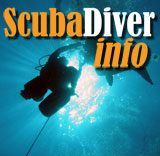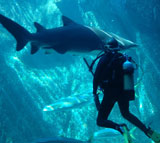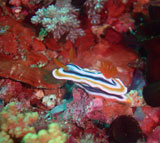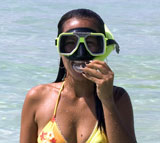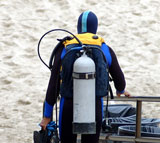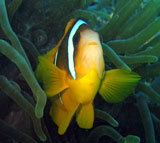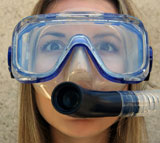Snorkels
by Conrad H. Blickenstorfer
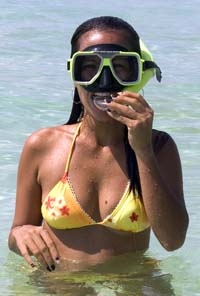 Almost everyone has played with a mask and snorkel at some point, even if only in a swimming pool. It's fun. The mask lets you look down into the water, exploring a whole new world, and the snorkel lets you breathe while doing so. Unfortunately, most people's exposure to snorkeling is limited to using a cheap mask and a basic snorkel, none of which work very well, and both of which can quickly turn people away from a wonderful, exciting sport. Yes, you don't even have to be a scuba diver to enjoy snorkeling (there, a snorkel is a required piece of safety equipment). It can be a sport all by itself. Almost everyone has played with a mask and snorkel at some point, even if only in a swimming pool. It's fun. The mask lets you look down into the water, exploring a whole new world, and the snorkel lets you breathe while doing so. Unfortunately, most people's exposure to snorkeling is limited to using a cheap mask and a basic snorkel, none of which work very well, and both of which can quickly turn people away from a wonderful, exciting sport. Yes, you don't even have to be a scuba diver to enjoy snorkeling (there, a snorkel is a required piece of safety equipment). It can be a sport all by itself.
On this page we tell you all about snorkels, what to look out for, and what features might make sense for you. Even a very good snorkel isn't terribly expensive, so you can experiment and you might even end up with a whole bunch, one for all the different kinds of diving and snorkling you might do.
What is a snorkel?
Basically nothing more than a tube that lets you breathe air with your head facing down and your face underwater. The snorkel has a mouthpiece that goes between the teeth, and a clasp or clip to secure it to the diving mask. Scuba divers use a snorkel not only as a safety device in case they have to float for extended periods of time while locating, or being located by, a boat; the snorkel is also used to swim to diving sites without using up precious air from the scuba tank.
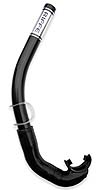 As you can imagine, snorkels come in many shapes, sizes, designs, colors, and they may or may not have all sorts of features. The biggest issue with a snorkel, of course, is that it must allow you to breathe air without letting water rush in. That is quite a challenge, and snorkel designers use all sorts of tricks to come up with the best possible solutions. And those solutions vary greatly for different applications. For example, almost all manufacturers offer "dry" snorkels with valves and splashguards designed to keep water out of the snorkel, with varying degrees of success. However, they also offer open designs because many divers and snorkelers prefer those. In addition, people have different preferences and so there are products for every taste, budget and purpose. As you can imagine, snorkels come in many shapes, sizes, designs, colors, and they may or may not have all sorts of features. The biggest issue with a snorkel, of course, is that it must allow you to breathe air without letting water rush in. That is quite a challenge, and snorkel designers use all sorts of tricks to come up with the best possible solutions. And those solutions vary greatly for different applications. For example, almost all manufacturers offer "dry" snorkels with valves and splashguards designed to keep water out of the snorkel, with varying degrees of success. However, they also offer open designs because many divers and snorkelers prefer those. In addition, people have different preferences and so there are products for every taste, budget and purpose.
All of this means that selecting the right snorkel is very important. Pick the wrong one, and not only won't you have any fun, but it can be downright dangerous. And keep in mind that breathing through a snorkel generally takes more effort that breathing without one. This is due to the fact that by using a snorkel, we are basically doubling the length of our air exchange distance. Our windpipe and a snorkel can add up to over two feet!
The snorkel shown above to the left is the Standard J from Riffe, a basic snorkel without any fancy features. Others are packed with all sorts of patended high-tech features. It all depends on what you want and need.
So what does a snorkel consist of?
There's the tube, of course, and that varies in length, bore diameter, and shape. Let's look at how each of those factors influences the snorkel.
A long snorkel obviously extends farther up above your head and there's less likelihood of water entering the tube. However, a long tube has a lot of volume and so a larger part of the air you breathe out will remain in the snorkel. They call that "stale" air. No big deal, but it's nicer to get fresh air. Also, when water enters the snorkel, a long tube takes in more of it, which makes it harder to purge it all by blowing into the tube.
A short snorkel tube doesn't have the stale air problem and is easier to clear and stow away, but it's easier to get flooded.
The bore, or inside diameter, of the tube is important as well. A large-bore tube with an inner diameter of about an inch is easiest to breathe through, but too much volume makes it difficult to purge water out of the snorkel, and a large diameter bore may also come with a mouthpiece too large to be comfortable for some divers. Fortunately, manufacturers have a very good handle of what lengths and bores work best, and you generally don't have to worry about bore. And many offer different size mouthpieces.
Next is the shape and contour of the tube. Most snorkels today are not just straight tubes. Instead, they contour around your head like state-of-the-art ski poles contour around a skier's body. We're not talking great advances in drag and dynamics here, but contoured tubes are functional and simply make sense.
But the snorkel consists of more than just the tube. There is the mouthpiece that may or may not be adjustable, and may or may not have a flexible "accordion" silicone tube so the mouthpiece bends out of the way when you don't need it. After the ease with which a snorkel lets you breathe, the mouthpiece is probably the next-most important thing. The mouthpiece must fit your mouth, or else it'll feel uncomfortable forever, and even may make you gag. Whether or not you like a flexible tube is a matter of preference. Some divers like the fact that the flex tube lets the mouthpiece get out of the way when it is not needed. Others prefer a rigid design. Do note that with rigid designs, the mouthpiece should be adjustable so that it is at the right angle to fit between your teeth. If you lean towards a flexible tube, be aware that if the inside of the flexible portion of the snorkel is ribbed (corrugated) it may retain water even after eliminating what has collected inside. So make sure the inside of the flexible hose is smooth.
While with masks, purge valves are an option that is not totally necessary, with snorkels they make total sense and you should probably get one that has a purge valve. Purge valves are one-way valves that eliminate all water from the snorkel when you blow into the tube. Some of the more sophisticated models even come with twin-valves. Yet others have self-draining mouthpieces or barrels so water goes out as soon as you're above the surface again. Or they may have a mouthpiece designed so that a small amount of water does not interfere with breathing.
The mouthpieces of quality snorkels have a rather large reservoir for allowing water to pool after clearing so that the snorkeler can breathe even if a bit of water remains. That way the snorkeler will take in air and not water on their first breath after the clearing procedure. However, we recommend the first breath after clearing be shallow.
Some snorkels have splash guards or valves at the end of the tube to keep water from entering while swimming. A few companies have come up with very sophisticated designs to seal the top of the snorkel as soon as it dips under water, and opens immediately once the intake tube is back up in the air. Some of these designs interrupt free breathing, and thus may not work well for all divers and snorkelers. However, many divers who use them say they quickly get used to such "dry" snorkels.
Snorkels attach to the headband of the diving mask via a clip. Clips should be easy to operate even with one hand, and the clip should be adjustable along the tube so you can fit the snorkel comfortably. Some divers guide them under the headband of the mask and keep them in place that way. Scuba divers may remove the snorkel underwater as it may dislodge the mask or get caught somewhere. However, many certification agencies require that the snorkel be in place and ready to be used at all times.
Some snorkels are of the folding type and fit into a much smaller place when storing them or traveling with them. That may be an important consideration.
Fashion statement
 Snorkels, perhaps more than any other diving gear, come in numerous colors and designs. It's not unusual for a manufacturer to offer the same snorkels in several bright colors, or even with stickers and other attention-getting paraphernalia. Snorkels, perhaps more than any other diving gear, come in numerous colors and designs. It's not unusual for a manufacturer to offer the same snorkels in several bright colors, or even with stickers and other attention-getting paraphernalia. The quartet to the left is Oceanic's Ultradry whose patented float system seals airways as soon as the snorkel becomes submerged. It comes in clear, yellow, blue and black. Compared to some other lines, this one is actually almost subdued.
Do I really need a snorkel?
A snorkel is obviously a great way to swim on the surface without using up air from the scuba tank. However, once underwater, it creates drag, can get entangled with things and can just generally feel like something you dont need hanging from your head. As a result, there are those who feel a snorkel isn't really necessary in many situations.
Always take a snorkel along when you go diving, and use it on dives where you may have to float on the surface before or after the dive (like waiting to be picked up by the boat). Snorkels also come in handy for just snorkeling between dives or when there's something to see from the surface.
Examples of different snorkels
A picture is worth a thousand words, so take a few minutes to examine the snorkels shown below. Each represents a different design and has different features.
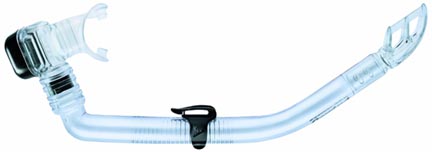
The Cressi Sigma snorkel shown above is designed for scuba diving. The tube doesn't have a flexible joint that can flop around and is secured to the mouthpiece holder with grooves and o-rings. This makes ascent with scuba gear easier and also comes in handy when the snorkel is put into and retrieved from a jacket pocket. Note the tapered tube with its profiled guard, and the large internal valve with a well for better drainage.

The Oceanic Response [above] has a dual exhaust and a self-venting purge valve which allows the diver to clear the snorkel of water with just a brief blow of air. Note the drop-away flexible mouthpiece. The mouthpiece is made of liquid silicone and can be replaced. You can even get a smaller mouthpiece with it.
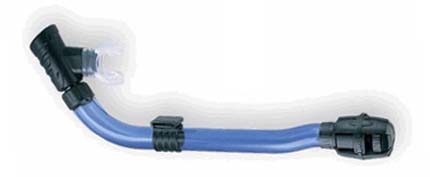
Above you see the Ocean Master Dry that uses a patented anti-pressure release valve design that keeps water out even if the snorkel intake is underwater. The Ocean Master Dry comes both in a flex and a non-flex version, and the company stresses that you'll never get any unwanted water.
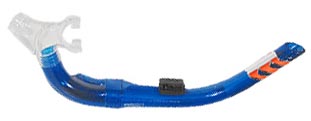
Scubapro's Twin Valve Shotgun 2 [above] uses an integrated twin-barrel design that makes purging water easy. The design uses a patended purge chamber for truly effortless clearing. This is a short, aggressively contoured snorkel designed for low drag. The clear silicone mouthpiece rotates for comfortable fit, and the quick-connect clip is among the best.
|
